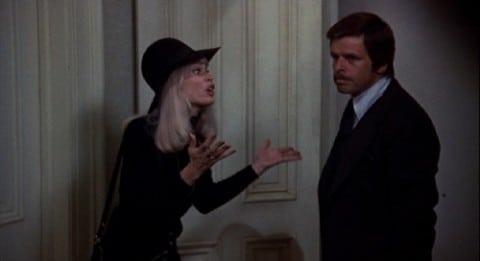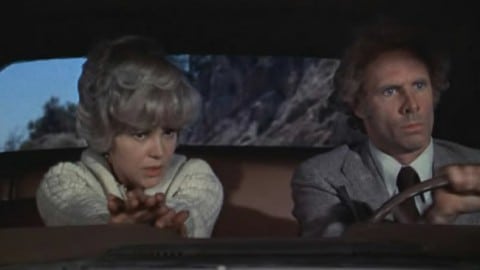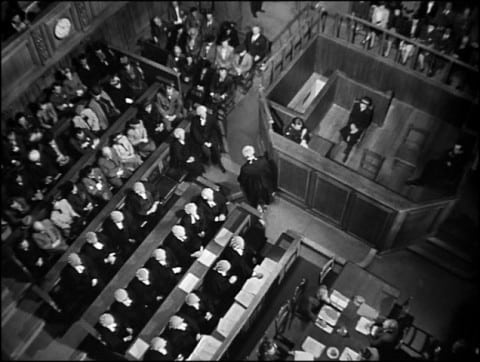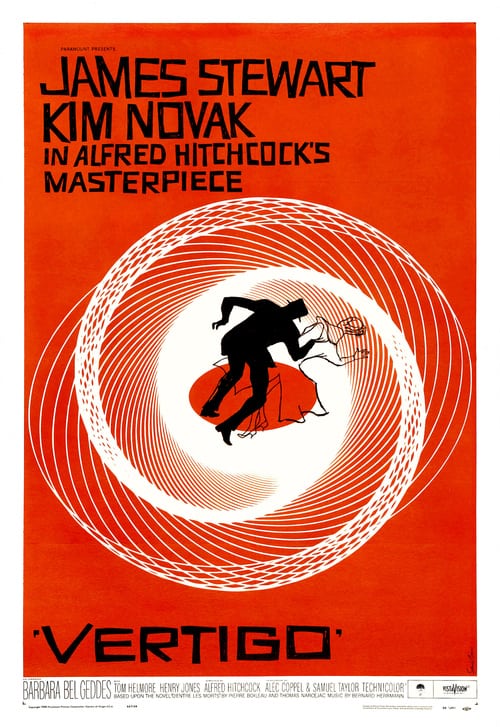Family Plot (1976)
Directed by: Alfred Hitchcock
Written by: Ernest Lehman, Victor Canning
Starring: Barbara Harris, Bruce Dern, Karen Black, William Devane
USA
AVAILABLE ON BLU-RAY AND DVD
RUNNING TIME: 120 min
THE HITCHCOCK CAMEO: Silhouetted, viewed through the frosted-glass door of the Registrar of Births and Deaths. Hitchcock appears to be arguing with an elderly woman and accusedly jabbing and pointing his finger.
REVIEWED BY: Dr Lenera, Official HCF Critic
A fake psychic, Blanche Tyler, and her boyfriend, George Lumley, attempt to locate the nephew of a wealthy and guilt-ridden elderly woman, Julia Rainbird. Julia’s deceased sister gave the baby boy up for adoption, but Julia now wants to make him her heir, and will pay Blanche $10,000 if the heir, Edward Shoebridge, can be found. Initially thought to be dead, George finds out that Edward murdered his adoptive parents, faked his own death and is now a successful jeweller in San Francisco known as Arthur Adamson, who, with his girlfriend Fran, kidnaps millionaires and dignitaries, returning them in exchange for ransoms in the form of valuable gemstones….
Hitchcock’s last film isn’t too great, though I like it a bit more than Torn Curtain and Topaz. Much like Frenzy, few seem to be in agreement as to its quality. Despite having death be a major background to the film with a fair amount of footage involving a [fake] medium supposedly contacting the dead and taking place in a graveyard, it’s a light, breezy picture, as cynical as Frenzy about us greedy, immoral humans but displaying more of a likeness for them. Largely lacking in suspense except in certain passages, it never gets as exciting as it should and isn’t even particularly funny, while for most of its duration it looks and feels less like a Hitchcock film than any picture he made since the silent days, mostly coming across as flat and almost like a TV movie. It never even really catches fire in the great Hitchcock fashion except for two or three sequences, and even they seem like shadows of what he would have done with the scenes years before. Nonetheless it’s a hard film to dislike, the story and characters are interesting, and the virtually symmetrical structure of two sets of characters getting ever closer to each other while basically going round in circles is clever [structurally the story is surprisingly similar to Psycho too]. The man was 76 years old when he made it and very ill whilst it was being shot, so it’s surprising that it actually came out as well as well as it did.
Family Plot saw the reuniting, though they had tried to set up several projects in the interim, of Hitchcock with his North By Northwest screenwriter Ernest Lehman. Lehman has previously rejected Victor Canning’s novel The Rainbird Pattern when it had been submitted to him as a potential project to either produce or write. Initially called One Plus One Equals One, then Deceit, the screenplay changed several times as Hitchcock kept pushing for a much lighter, more upbeat film very different in tone to the dramatic and dark book, in particularly removing the many deaths except for one accidental one and having a happy ending, and also leaving the Los Angeles and San Francisco locations vague. Universal wanted big stars, and Burt Reynolds, Roy Scheider, Al Pacino, Liza Minnelli and Goldie Hawn were all considered, but Hitchcock didn’t want to pay large salaries which would detract from the film’s budget. William Devane was his first choice for the role of nefarious jeweller Arthur Adamson, but Devane was unavailable when the film went into production so Hitchcock settled on Roy Thinnes and shot several scenes with him, only to fire him when Devane became available. Some shots of Thinnes as the character seen from behind remain in the film. Hitchcock unusually encouraged improvisation on set but his illness meant that a few scenes were directed by other hands. Family Plot was released to moderate reviews and box office, and Hitchcock did begin work on the screenplay for a spy thriller called The Short Night, but died before filming at the age of 80 in his Bel Air home of kidney failure on 29 April 1980
Family Plot’s brief opening titles, which only credit Lehman and Hitchcock, are seen in a crystal ball which of course turns out to be the ball with which our fake medium Blanche pretends to contact the dead. The scenes of her going over the top so her clients are totally convinced by the charade are the film’s most amusing, though more amusing in a different way, or maybe more distracting, is the next scene set in a car where Barbara Harris’ head has a green outline throughout. Even worse is another car scene later which has shots where Bruce Dern appears totally transparent and you can clearly see the passing street lights and car headlights go right through his head, while some of the back projection throughout the film looks horrendous and sometimes even green. Hitchcock had intended to film the car scenes in Family Plot using traditional rear screen projection, in which footage is run off of a projector on a screen behind the performers, but Universal suits convinced him to use a new method which was cheaper that had him shoot the scenes of people in cars with total blackness behind them and the background process footage be inserted in the laboratory when the film was in post-production. Hitchcock was reportedly appalled by the results and the method wasn’t used again. It does make the film’s most potentially exciting scene – George and Blanche careering down a mountain road in their car because the brakes have been tampered with – rather laughable, though it seems to be partly tongue in cheek anyway.
The story progresses leisurely and too much of the plot consist of characters telling things to others, though the film does hold the attention even if it seems that the ailing director isn’t really present for quite a while considering the rather mundane handling, the first moment that has have the Hitchcock touch coming about half an hour in with George visiting a garage where at last we get some well chosen shots and sharp editing. Thereafter the pace does pick up somewhat as one of the film’s couples tries to get rid of the other, though there’s not really enough excitement and the expected big set pieces don’t really occur, Hitchcock choosing to be mostly content with more low key highpoints like a cemetery stalking shown from above, the intertwining pathways symbolic of the film’s story itself. Meanwhile the dark and light elements of the tale sometimes seem to be existing in different films. The plotting is neat though and the whole thing is still quite fun throughout, while we finally get some genuine tension when George is looking for Blanche in the house of Arthur and Fran, though a potentially thrilling climax doesn’t occur at all and the story ends in both a lazy and ludicrous manner. The film’s final shot of Blanche winking at the audience is in many ways a fitting conclusion to Hitchcock’s career though, the man, who may have been well aware Family Plot could be his last movie, deciding to say farewell to moviegoers in his guise as entertainer, rather than frightener or anything else.
As with Topaz, Family Plot could have done with being a lot shorter, and, similarly with that film, Hitchcock and his screenwriter sometimes appear to assume that the people watching the film are idiots, with a desire to explain something that occurs in a scene with its following scene. There’s a good moment where a bishop is kidnapped right in the middle of a church service, but the script feels the need for the kidnappers to then explain why the congregation [who are in a church remember] didn’t re-act to the crime unfolding right in front of their eyes. The characters are appealingly quirky, and Fran’s malevolent outfit of black hat, black dress, large black sunglasses obscuring the face and a long blonde seems to have inspired the appearances of Bobbi in Dressed to Kill and Hannibal Lecter’s end-of-movie disguise in The Silence of the Lambs. Lehman’s script really is a mixed bag though, such as some sexual references which, while still just about ‘PG’ worthy, seem to have been put in because: “Hey, it’s the 70’s” and feel out of place. Despite Family Plot being supposedly a comedy thriller, the laughs are few and far between and extremely muted, mostly restricted to the last sentence of a scene just before it switches to another. I did chuckle at a bit where George is waiting for someone in a diner and is distracted by a priest coming in with some kids to sit down, who then goes to sit with his secret female friend when she comes in.
Barbara Harris as Blanche stands out amongst the cast, achieving the difficult task of being kooky but not annoying, but Devane, Dern and Black are all excellent and Family Plot wouldn’t be nearly as good without them. The playful score by John Williams is also a highlight, really helping to carry the film along and pepper over its dull passages. There’s effective use of organ and harpsichord, an atmospheric ethereal theme for Blanche, and a great breezy tone throughout, Williams nailing the film so much that I reckon he would have been Hitchcock’s composer of choice if he’d gone on to make more films. Sadly he didn’t. Family Plot is a very unassuming, laidback conclusion to an incredible career – I mean how many other filmmakers made as many films as he did and have the majority of them be good or more? – and it has all sorts of issues, but in a way it’s a nicely offbeat, unpredictable signing off.
Rating: 

















Be the first to comment